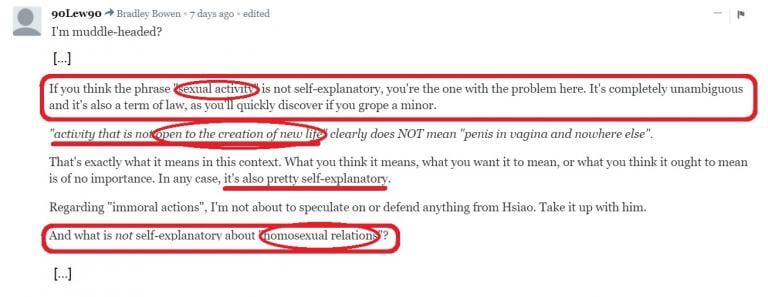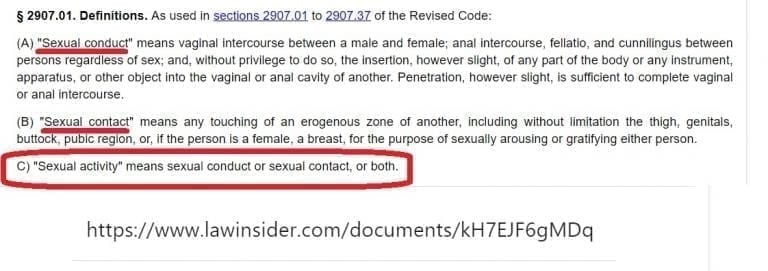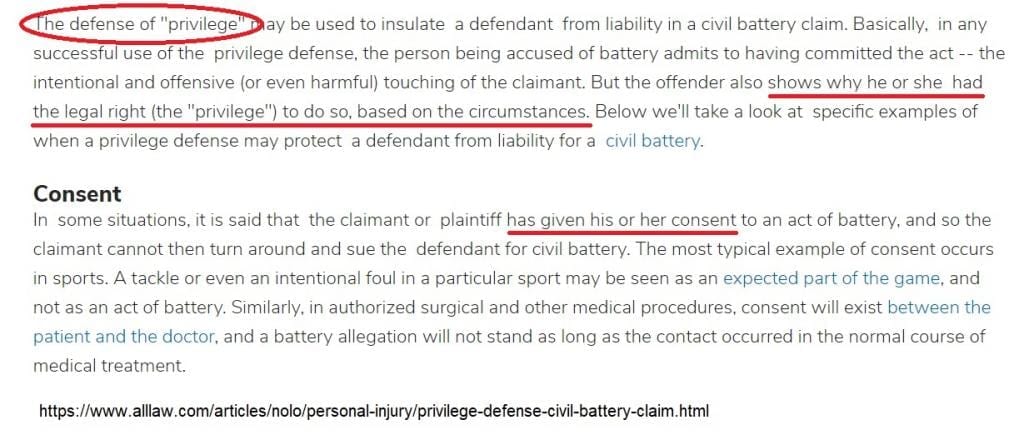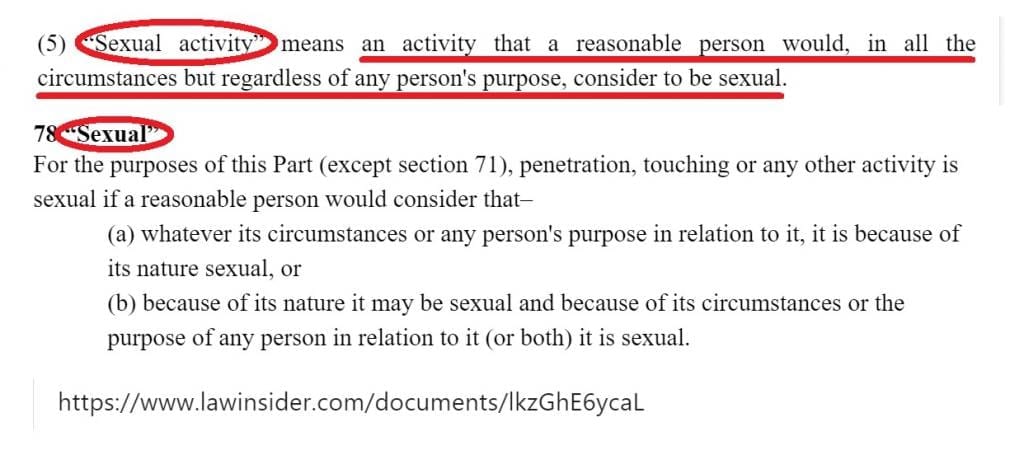Aquinas and Homosexual Sex – Part 8: Legal Definitions
WHERE WE ARE
Sometimes, Christian philosophers put forward pieces of crap that they pretend to be philosophical arguments, but that are just word salads that are posing as philosophical arguments. The core “argument” in Tim Hsiao’s article “A Defense of the Perverted Faculty Argument against Homosexual Sex” (hereafter: PFA) appears to me to be one such faux argument. Hsiao fails to define or to clarify ANY of the basic terms and phrases in his core “argument”, making it a string of words that cannot be rationally evaluated.
Here is the core “argument” in PFA:
4. All sexual activity that is not open to the creation of new life is immoral.
A. All homosexual activity is sexual activity that is not open to the creation of new life.
THEREFORE:
7A. All homosexual activity is immoral.
This is NOT an actual argument, because an argument consists of claims (premises) that are given in support of another claim (the conclusion). But NONE of the three sentences above is a claim. These are declarative sentences, so they look and sound like claims, but they are TOO UNCLEAR to be rationally evaluated as true or false, or as probable or improbable. Declarative sentences that are too unclear to be rationally evaluated are NOT claims. So, these three sentences are FAUX claims or PSEUDO claims, not actual claims.
These sentences are in the form of a categorical syllogism, so taken together they look and sound like an argument, but this is NOT an actual argument, because the sentences do not make actual claims. Because these sentences are NOT claims, this collection of sentences is NOT an actual argument, but is a FAUX argument or a PSEUDO argument. This is just a word salad that Hsiao is pretending to be an argument.
Unless and until Hsiao can figure out what he means by the four UNCLEAR terms in these sentences and then spells out the meanings of these terms so that others can be let in on his little secret, God only knows what the hell these three sentences mean.
THE TERM “SEXUAL ACTIVITY” IN THE LEGAL SPHERE
One of the UNCLEAR phrases in Hsiao’s core “argument” is the phrase “sexual activity”.
According to 90Lew90, however, this phrase is “completely unambiguous”:
90Lew90 is correct that “sexual activity” is a term of law, but instead of providing a reason or justification for his IDIOTIC claim, he points us to a mountain of evidence that proves the very opposite of his claim. If you look at the dozens and dozens of different legal definitions of the phrase “sexual activity” the idea that this phrase is “completely unambiguous” quickly becomes ABSURD and impossible for any rational person to believe.
In Part 7 of this series, I pointed out that there are dozens and dozens of different legal definitions of the phrase “sexual activity”, and that the obvious and apparent variety of different definitions makes the claim that this phrase is “completely unambiguous” extremely dubious.
In this post I will examine a number of these legal definitions, and point out specific differences and contradictions between them. This will show beyond any reasonable doubt that the phrase “sexual activity” is NOT “completely unambiguous” but, rather, that this phrase is undeniably ambiguous, and that it was foolish of 90Lew90 to point us towards the legal use of this phrase as evidence for his view.
A COMPARISON OF SOME LEGAL DEFINITIONS OF “SEXUAL ACTIVITY”
==>DEFINITION #1 (or D#1)
D#1 specifies two different categories of “sexual activity” and clarifies what each of those two categories includes.
The first category is that of “sexual conduct” which is, roughly speaking sexual intercourse. Note that there is no requirement concerning the PURPOSE of these actions. Also note that the people engaged in the activity must be “without privilege to do so”. I believe this means that the people who are engaging in the activity do not have a legal right or permission to do so. For example, if a man has sexual intercourse with a woman who does NOT WANT to have sexual intercourse with that man and has NOT CONSENTED to have sex with the man, then that man does not have “privilege” to have sex with that woman at that time:
If I understand that condition correctly (“without privilege to do so”), then this definition clearly implies that when an adult man and adult woman both willingly engage in sexual intercourse, that would NOT COUNT as “sexual activity” (in most cases) according to D#1, because sexual intercourse between two consenting adults is generally legally permissible (at least when done privately as opposed to in public). But most of us would consider sexual intercourse between two consenting adults (in private) to constitute a clear example of “sexual activity”, so this legal definition is definitely in conflict with how most people use the term “sexual activity”.
The second category is that of “sexual contact” which is “any touching of an erogenous zone of another” which is done for a particular PURPOSE: “the purpose of sexually arousing or gratifying either person” (i.e. either the person who is doing the touching or the person who is being touched). This condition has a rather interesting implication. If a man fondles and kisses and licks the naked breasts of a woman as part of a sex show NOT in order to sexually arouse or gratify himself or the woman, but rather for the purpose of sexually arousing or sexually gratifying the patrons who paid to watch the sex show, then this activity would NOT COUNT as “sexual contact” and thus would also NOT COUNT as “sexual activity” according to D#1! Once again, this implication is contrary to how most people would be inclined to use the term “sexual activity”.
Because the touching must be “of another” in order to be categorized as a “sexual contact”, this definition EXCLUDES public masturbation! So, if a man takes off his pants in public, and masturbates in public, because he is not touching “another” person, this activity would be EXCLUDED by D#1, and thus would NOT COUNT as a “sexual activity”. However, most people would consider public masturbation to be a clear case of “sexual activity”, and thus D#1 departs from how most people would use this term.
It is NOT clear on D#1 whether a medical examination involving the insertion of a medical device into the vagina of a woman would COUNT as a “sexual activity”. It depends on whether the doctor is considered to have done this “without privilege to do so”. Most of us would ASSUME that consenting to have a medical doctor conduct such an examination would give the doctor the LEGAL RIGHT to insert the medical device into the vagina of the woman, but D#1 does not explicitly spell out the conditions for having “privilege to do so”. Taken straightforwardly, D#1 categorizes “the insertion…of…any instrument…into the vaginal cavity of another” to constitute a “sexual activity”, even in the case where a medical doctor inserts a medical instrument into a woman’s vagina as part of a legitimate medical examination or procedure, which is contrary to how most people would use the term “sexual activity”.
==>DEFINITION #2 (or D#2)
Unlike D#1 this definition does NOT divide “sexual activity” into two different categories (e.g. intercourse vs. sexual touching), but focuses exclusively on intercourse or penetration. So D#2 EXCLUDES various sorts of sexual touching that are specifically INCLUDED by D#1. These two definitions clearly have very different implications concerning what is to count as a “sexual activity”.
Clearly D#2 EXCLUDES passionate kissing and French kissing because that activity does not involve “penetration” nor does it involve “union with…the sexual organ of another”. Many people, however, would consider passionate kissing and French kissing to be examples of “sexual activity”. So, D#2 appears to differ from how many people would use the term “sexual activity”.
D#2 does not mention breasts. That means that if a man fondles, kisses, and licks the naked breasts of a woman for the purpose of sexually arousing himself and/or the woman or for the purpose of sexually gratifying himself and/or the woman, this does NOT COUNT as a “sexual activity” according to D#2. However, most people would consider such activity to constitute a clear example of “sexual activity”, so D#2 EXCLUDES an activity that most people would consider to be a “sexual activity”.
Furthermore, D#1 does explicitly mention the touching of a female “breast” as being a “sexual activity” if done for the PURPOSE of sexual arousal or sexual gratification of the person doing the touching or the female whose breast is being touched. So, D#2 EXCLUDES an activity that is specifically INCLUDED by D#1.
Sucking on the toes of another person can be (and usually is) considered to be a sexual activity, but there is no mention of “toes” in D#2, and this definition is focused on sexual intercourse and penetration, so it EXCLUDES the activity of one person sucking on the toes of another person. In that respect, this definition appears to depart from how most people would use the term “sexual activity”.
Like D#1, this definition requires that the sexual activity involve touching or penetration of “the sexual organ of another”. So, D#2 also EXCLUDES public masturbation, which does not involve touching or penetration of “the sexual organ of another” person. Public masturbation would NOT COUNT as a “sexual activity” according to D#2. However, most people would consider public masturbation to be a clear case of a “sexual activity”, so D#2 clearly departs from how most people use this term.
Unlike D#1, there is no requirement in D#2 that the people engaged in sexual intercourse be “without privilege to do so”, therefore if we consider an adult man and an adult woman who both willingly engage in sexual intercourse with each other (in private) this would COUNT as a “sexual activity” according to D#2, which corresponds with how most people use this term, in contrast with D#1.
Note that there is no requirement in D#2 that anyone engaged in the activity have a particular PURPOSE. However, there is an interesting EXCLUSION based on “bona fide medical purpose”. For example, if a medical doctor touches the vagina of a woman or inserts a medical tool into the vagina of a woman as part of a legitimate medical examination (that the woman has agreed to), then this action would NOT be considered to be a “sexual activity”, which is in keeping with how most people use the term “sexual activity”. This is a very interesting exclusion, because very few definitions of “sexual activity” include such an exclusion, and thus most definitions that fail to require a particular PURPOSE (such as sexual pleasure or sexual gratification) would INCLUDE legitimate medical examinations of sexual organs as being a “sexual activity”!
==>DEFINITION #3 (or D#3)
Like D#1 and unlike D#2, this definition INCLUDES more than just sexual intercourse or penetration. So, D#3 clearly has different implications than D#2 concerning what is to count as a “sexual activity.”
Because specific body parts are required to be involved by D#3, and because lips and tongues are not among the specified body parts, passionate kissing and French kissing would be EXCLUDED by D#3. However, if lips and tongues are considered “erogenous zones”, then D#1 would INCLUDE passionate kissing and French kissing (if done for the purpose of sexually arousing or gratifying one or both kissers). So, D#3 might well have different implications than D#1 concerning what counts as a “sexual activity”.
Because D#3 specifically mentions “female breasts” this definition would INCLUDE the activity of a man fondling, kissing, and licking the naked breasts of a woman, while D#2 clearly EXCLUDES such an activity. So, the implications of D#3 clearly differ from the implications of D#2, concerning what activities count as being a “sexual activity”.
Like D#2 and unlike D#1, this definition of “sexual activity” does NOT require that the people engaged in the activity be “without privilege to do so”. So D#3 INCLUDES consensual sexual intercourse between an adult man and an adult woman.
It is not clear whether D#3 refers to any sort of PURPOSE. It uses the vague term “of a sexual nature” as a requirement, but it is not clear whether this implies any particular sorts of PURPOSES on the part of the agents. If this is a reference to the purpose of sexually arousing or sexually gratifying one of the people involved in the activity, then D#3 would have some similarity to D#1 which specifies one sub-category of “sexual activity” in terms of such purposes. This would also make D#3 significantly different from D#2 which makes no reference to the purposes of the people involved in the activity.
However, because the expression “of a sexual nature” is VAGUE, we cannot determine whether this refers to the purposes of the agents, nor can we clearly determine what particular purposes this expression might be attempting to specify. In this respect D#3 is less clear than D#1, because D#1 explicitly spells out what sort of PURPOSES are relevant to the application of the term “sexual activity”.
The requirement that the activity be “of a sexual nature” might, however, be sufficient to EXCLUDE legitimate medical examinations of genitals by a medical doctor.
==>DEFINITION #4 (or D#4)
D#4 defines “sexual activity” not in terms of TWO categories (like D#1 does), but in terms of THREE categories:
- penetration
- touching
- any other activity
That means that the scope of D#4 extends beyond the scope of both D#1 and D#2. It INCLUDES some activities that are neither penetration nor sexual touching, while D#1 includes only those sorts of activities, and D#1 includes only penetration or intercourse. Clearly D#4 has different implications compared to D#1 and D#2 concerning what COUNTS as being a “sexual activity”
D#4 also specifies THREE different ways that an activity could be classified as being “sexual”:
- because of the nature of the activity (apart from the circumstances or purposes of the activity)
- because of the circumstances of the activity
- because of the purposes of any person in relation to the activity
The definition FAILS to specify or clarify any of the three different ways that an activity could be considered to be “sexual”, so these three different sub-categories are UNCLEAR and are not very helpful.
Because of it’s broader scope D#4 might well INCLUDE passionate kissing and French kissing. It might well also INCLUDE public masturbation. Thus, the broader scope of D#4 seems to be closer to the scope of how most people use the term “sexual activity”.
However, because of the vagueness of D#4, there may be many cases or examples where it is difficult to determine with confidence whether that activity COUNTS as being “sexual”. In this respect D#4 is more UNCLEAR than the previous definitions.
==>DEFINITION #5 (or D#5)
This definition requires “physical contact” that is either “direct or indirect” and that falls under one of two categories:
- which is intended to erotically stimulate either person or both
- which is likely to cause erotic stimulation in either person or both
No specific body parts are mentioned in D#5. The first category concerns the INTENDED PURPOSE of the activity, and the second category concerns the LIKELY EFFECT of the activity.
Because of the phrase “either person or both” it appears that this definition is focused on activity involving two or more persons, and thus this definition appears to EXCLUDE public masturbation. However, public masturbation is an activity that most people would consider to be a clear case of a “sexual activity”, so D#5 appears to be in conflict with how most people would use the term “sexual activity”.
Because D#5 does not specify particular body parts, it has a broader scope than some of the previous definitions. This definition, for example would INCLUDE passionate kissing and French kissing because these activities could be done “to erotically stimulate either person or both”. A man fondling, kissing, and/or licking the naked breasts of a woman could be done “to erotically stimulate either person or both”.
Furthermore, since a person who engages in sucking the toes of another person usually does this “to erotically stimulate either person or both”, toe sucking would be INCLUDED by this definition. So, D#5 INCLUDES more than D#2, which focuses on sexual intercourse or penetration.
Because the focus of this definition is on the purpose of erotic stimulation (or the likely effect of erotic stimulation), a medical examination of the genitals of a patient by a medical doctor would (generally) be EXCLUDED by D#5, in keeping with how most people use the term “sexual activity”.
==>DEFINITION #6 (or D#6)
Unlike ALL of the previous five definitions, D#6 INCLUDES a category of “soliciting” activities “of a sexual nature”. So, in that respect, this definition is broader than all the the previous five definitions. Soliciting sexual intercourse would COUNT as a “sexual activity” under this definition. Soliciting fondling for the purpose of causing sexual arousal would also COUNT as a “sexual activity”, and soliciting someone to engage in passionate kissing or French kissing would COUNT as a “sexual activity”. None of this would COUNT as a “sexual activity” under ANY of the previous five definitions.
This definition also specifically INCLUDES “kissing” and “fondling” of “parts of the body meant to cause sexual arousal”. So, D#6 INCLUDES passionate kissing and French kissing, and it INCLUDES a man kissing and fondling the naked breasts of a woman (when this is done to cause sexual arousal), and it would appear to also INCLUDE the activity of toe sucking.
Because there does not appear to be a requirement in D#6 that two or more people are engaging in the activity, it appears that this definition also INCLUDES public masturbation (involving just one person).
CONCLUSION
Each of the six LEGAL definitions of “sexual activity” considered above is significantly different than the others. Each of these definitions has different implications concerning what COUNTS as a “sexual activity”.
Many, if not all, of these definitions INCLUDE (or EXCLUDE) examples that most people would not INCLUDE (or EXCLUDE) and thus depart from how most people use the term “sexual activity”. Because the various legal definitions of “sexual activity” disagree with each other, and often depart from how most people use the term “sexual activity”, these definitions of the term “sexual activity” provide powerful evidence that the phrase “sexual activity” is NOT “completely unambiguous”.
In pointing to the use of the phrase “sexual activity” in the legal and criminal arena 90Lew90 FAILS to establish his views about the meaning of this phrase, and instead points us to information that clearly proves his claims to be FALSE. The phrase “sexual activity” is NOT clear; the meaning of this phrase is NOT “completely unambiguous”; the meaning of this phrase is NOT obvious. Rather, the meaning of the phrase “sexual activity” is UNCLEAR and AMBIGUOUS, and it is in need of definition or clarification.
The UNCLARITY of the phrase “sexual activity” supports my view that sentence (4) and sentence (A) of Hsiao’s core “argument” are both FAUX claims, and thus that his core “argument” is not an actual argument, but is a FAUX argument that merely looks and sounds like an argument.
For many more LEGAL definitions of the phrase “sexual activity”, see this website: https://www.lawinsider.com/dictionary/sexual-activity
PS
I have no interest in wasting my time attempting to evaluate Hsiao’s FAUX argument. However, I will check out the efforts by Edward Feser to support and defend a version of the Perverted Faculties Argument in order to determine whether Feser manages to present an ACTUAL argument, an argument that is composed of ACTUAL claims. If Feser seems to present an ACTUAL argument, then I will attempt to evaluate that argument.








